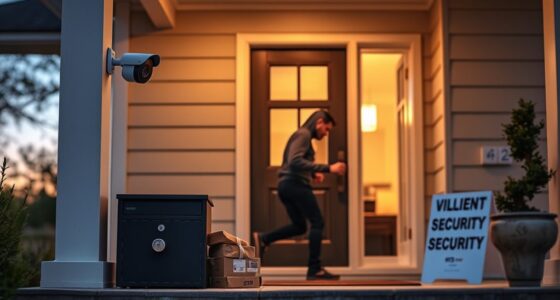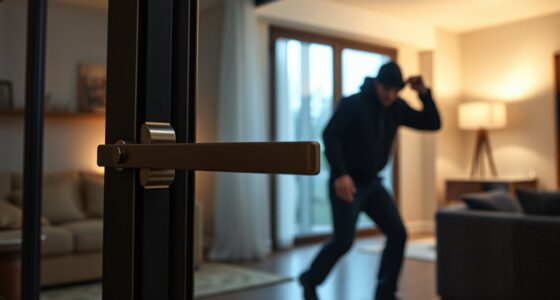To conceal valuables without a safe, consider hiding them inside everyday furniture like false drawers or secret compartments built into desks or dressers. You can also use false electrical outlets to store small items behind the faceplate or hide valuables behind hidden panels in walls or furniture. Keep these spots in plain sight but uncommon for valuables. Curious how to make these hiding spots even more discreet? Keep exploring for clever ideas that blend seamlessly into your space.
Key Takeaways
- Use hidden drawers built into furniture like desks or dressers with false bottoms for discreet storage.
- Install false electrical outlets in less-frequented rooms to conceal valuables behind the faceplate.
- Place concealed compartments behind false panels or inside false walls for added security.
- Opt for inconspicuous spots such as behind picture frames or inside hollowed-out books.
- Choose easily accessible yet discreet locations, blending storage spots into everyday objects and fixtures.

When it comes to safeguarding your valuables, a safe isn’t always the best option. Safes can be bulky, expensive, and sometimes obvious to intruders. Instead, clever concealment strategies can keep your valuables hidden in plain sight, making it less likely that someone will stumble upon them. One effective method is using a hidden drawer. These are built into furniture like desks, dressers, or even false bottoms in drawers. By installing a hidden drawer in a piece of furniture you frequently use, you create a discreet compartment that blends seamlessly with your surroundings. To make it even more secure, consider lining the compartment with a thin layer of padding or a false bottom so it appears ordinary. This way, even someone inspecting your furniture closely might overlook the secret space.
Clever concealment like hidden drawers can discreetly protect your valuables in plain sight.
Another popular concealment tactic is a false electrical outlet. These are specially designed outlets that look exactly like real ones but contain a hidden compartment behind the faceplate. You can install a false electrical outlet in a common area like your living room or kitchen wall. Behind the faceplate, you can stash small valuables such as jewelry, cash, or important documents. Because electrical outlets are so common, intruders rarely give them a second glance, making this a surprisingly effective hiding spot. Plus, replacing a standard outlet with a false one is straightforward, and the setup remains inconspicuous.
Both the hidden drawer and false electrical outlet work because they leverage everyday items and fixtures, turning ordinary objects into covert hiding spots. The key is choosing locations that seem unremarkable and unlikely to attract suspicion. For example, a false electrical outlet in a rarely used room or a hidden drawer tucked behind a false panel in your furniture minimizes the chances of discovery. When installing these concealment options, keep in mind that accessibility matters; you want to be able to retrieve your valuables easily but not so often that it raises questions. Additionally, utilizing color accuracy in your concealment areas can help make the hidden spots blend even better with their surroundings.
Using these methods doesn’t require extensive remodeling or costly security measures. Instead, it’s about smart placement and blending your valuables into your regular environment. By doing so, you improve your chances of keeping your prized possessions safe from theft or prying eyes. Remember, the goal isn’t just to hide valuables but to do so in a way that’s both discreet and practical. With a little creativity and some simple modifications, you can turn everyday objects and fixtures into effective safekeeping spots that intruders are unlikely to suspect.
Frequently Asked Questions
Are Hidden Compartments Within Furniture Effective for Securing Valuables?
Hidden compartments within furniture, like disguised safes, can be quite effective if you choose well-crafted options. They blend seamlessly with your decor, making it hard for intruders to spot them. You get quick access to your valuables while keeping them safe from casual thieves. Just guarantee the compartments are sturdy, discreet, and well-hidden, so they don’t draw unwanted attention or become easy targets.
How Can I Disguise Valuables in Everyday Household Items?
Think of your home as a treasure chest, and you’re the pirate hiding your loot. You can use disguise techniques to hide valuables in plain sight, like placing jewelry inside a hollowed-out book or stashing cash in a sealed vacuum-sealed food bag. Everyday items such as empty cans, false-bottomed containers, or disguised jars make perfect hiding spots. These clever techniques keep your valuables safe and out of the wrong eyes.
What Are the Best Locations to Hide Valuables Away From Common Access?
You should consider using hidden safes installed in discreet locations like behind wall panels or inside furniture. Outdoor hiding spots, such as buried containers or within thick bushes, can also be effective if protected from weather. Avoid obvious spots like under doormats or in plain sight. By choosing unconventional, secure locations, you reduce the risk of theft and keep your valuables safe from common access.
Is It Safe to Use False Outlets or Wall Panels for Hiding Items?
Using false outlets or wall panels can be reasonably safe if you reinforce them properly, but they aren’t as secure as electronic safes with biometric locks. Investigating these hiding spots shows burglars often check such spots first. While they’re good for quick access, for valuable items, opt for a high-quality safe. Electronic safes with biometric locks offer better security, making your valuables much harder for intruders to find or steal.
Can Concealed Storage Solutions Be Easily Discovered by Intruders?
Concealed storage solutions can be vulnerable to detection risks if intruders are thorough. While clever hiding spots may deter casual thieves, determined intruders with experience can sometimes identify security vulnerabilities, especially if the concealment isn’t well-hidden or looks suspicious. To minimize detection risks, choose discreet locations, avoid common hiding spots, and consider additional security measures, like alarms or cameras, to protect your valuables effectively.
Conclusion
So, next time you think a fancy safe is your best bet, remember, some of the cleverest hiding spots are right under your nose—literally. Ironically, the simplest places often make the best concealments. You might hide your valuables perfectly, only to forget where you put them yourself! It’s almost poetic: the most obvious spot becomes the most secure, proving that sometimes, the best security is just a good laugh at your own expense.









